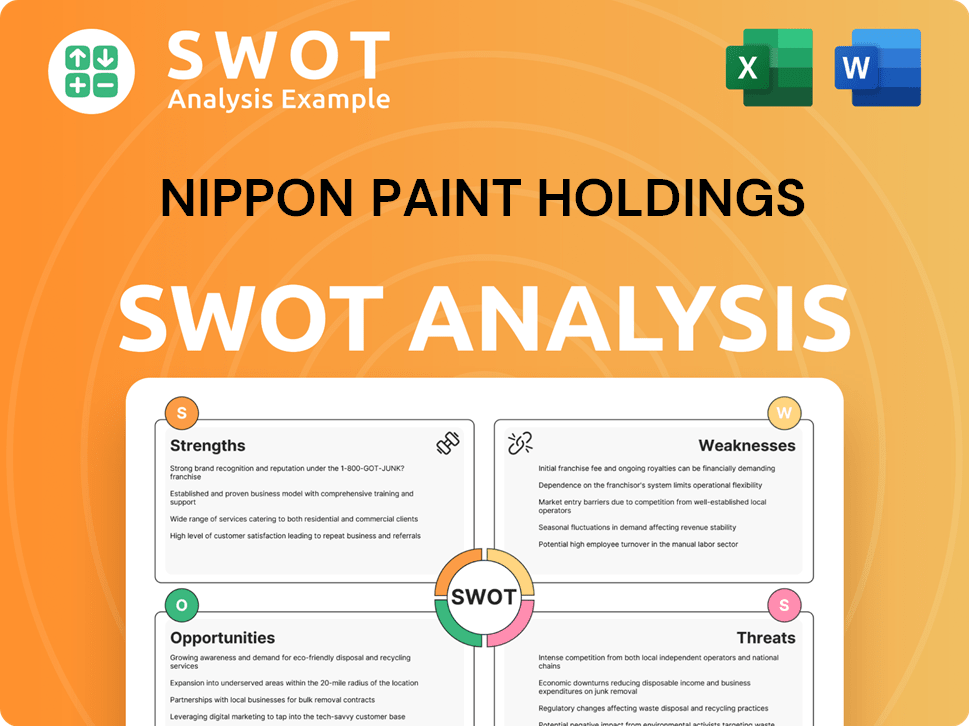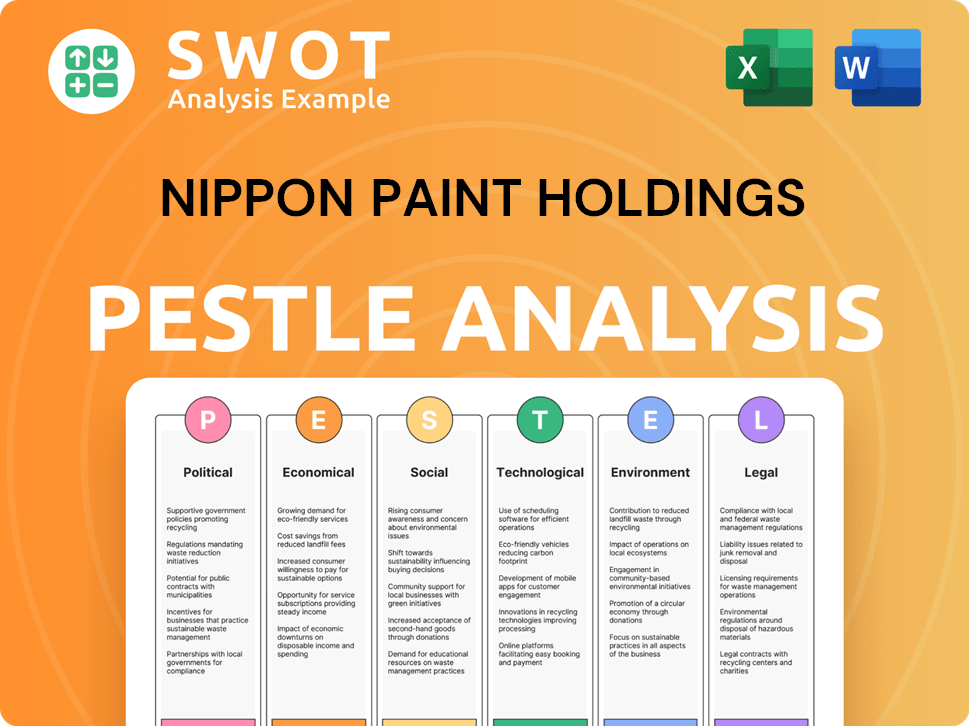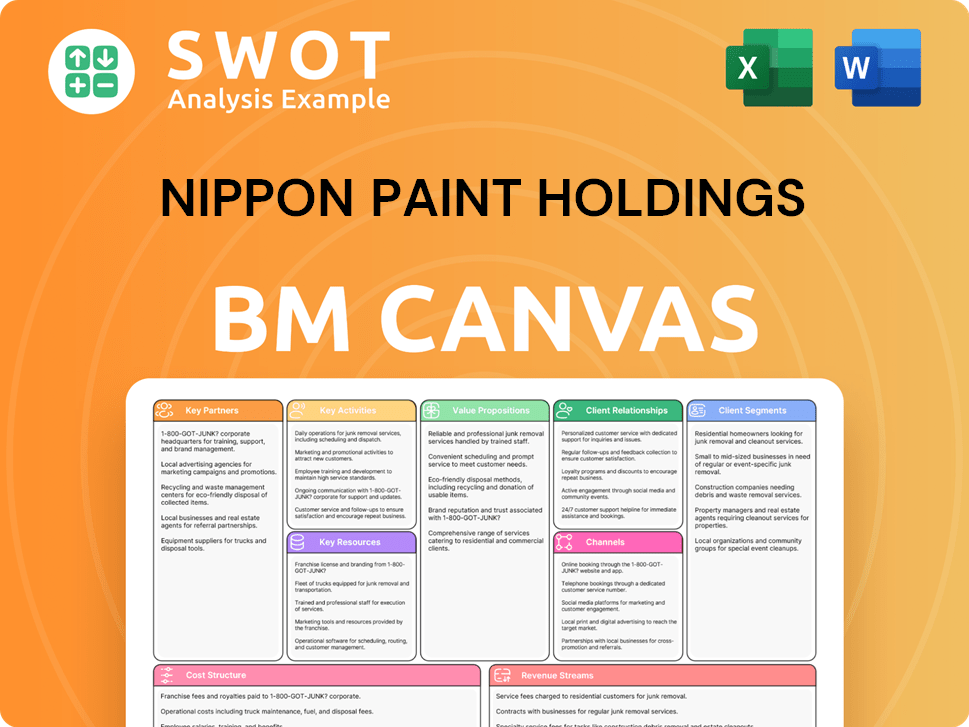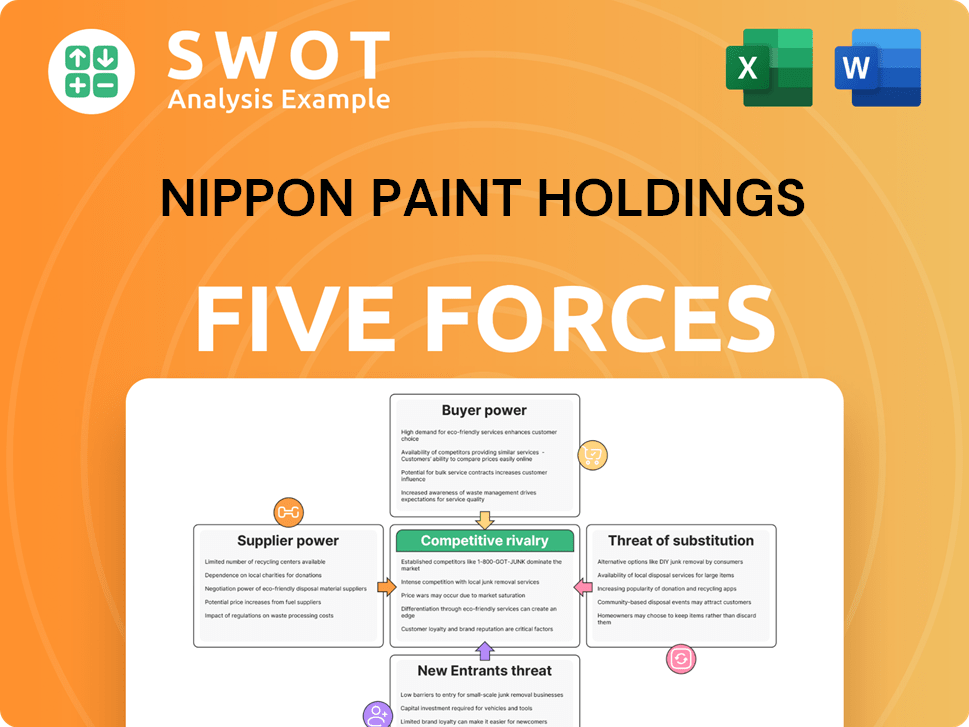Nippon Paint Holdings Bundle
Who Buys Nippon Paint? Unveiling the Customer Demographics and Target Market
In today's evolving market, understanding the customer is paramount. For Nippon Paint Holdings Company, grasping its customer demographics and target market is essential for navigating the complexities of the global coatings industry. The shift towards sustainability and eco-friendly products has reshaped consumer preferences, directly impacting Nippon Paint's strategic direction and product offerings. This analysis dives deep into Nippon Paint's customer profile.

From its origins in 1881, Nippon Paint has evolved from serving local artisans to catering to a diverse, global customer base. This Nippon Paint Holdings SWOT Analysis provides a comprehensive overview of the company's strengths and weaknesses in relation to its target market. This exploration will provide valuable Nippon Paint consumer insights, revealing the company's audience segmentation and how it adapts to meet the needs and wants of its customers, including a detailed Nippon Paint market analysis.
Who Are Nippon Paint Holdings’s Main Customers?
Understanding the Revenue Streams & Business Model of Nippon Paint Holdings requires a deep dive into its customer demographics and target market. The company strategically segments its customer base to effectively cater to diverse needs. This approach allows for tailored product offerings and marketing strategies, maximizing market penetration and customer satisfaction.
Nippon Paint's customer profile spans both consumer (B2C) and business (B2B) segments, each with distinct characteristics and purchasing behaviors. Analyzing these segments is crucial for understanding the company's overall market position and future growth potential. The company's success is heavily reliant on its ability to meet the specific demands of each customer type.
For the B2C segment, Nippon Paint focuses on homeowners and DIY enthusiasts. This segment is driven by aesthetic preferences, ease of application, and product durability. The B2B segment includes automotive, industrial, marine, and construction industries. Key customers here prioritize product performance, compliance, cost-efficiency, and technical support. In 2024, Nippon Paint's automotive and industrial coatings segments showed strong performance.
The B2C segment of Nippon Paint targets homeowners and DIY enthusiasts. This customer base typically includes a broad age range, varying income levels, and diverse preferences. Purchasing decisions are often influenced by factors such as color choices, ease of use, and the overall aesthetic appeal of the final product.
The B2B segment caters to various industries, including automotive, industrial, marine, and construction. Key customers include automobile manufacturers, industrial equipment producers, shipbuilding companies, and large-scale construction firms. Decision-makers in this segment prioritize product performance, regulatory compliance, and cost-effectiveness.
Nippon Paint's customer needs and wants vary significantly between B2C and B2B segments. B2C customers seek aesthetically pleasing, easy-to-apply, and durable products. B2B customers require high-performance coatings that meet strict industry standards and offer cost-efficiency. Understanding these distinct needs is crucial for product development and market strategy.
Nippon Paint employs a comprehensive customer segmentation strategy. This involves dividing the market into distinct groups based on demographics, needs, and behaviors. By tailoring its products and marketing efforts to each segment, the company maximizes its market share and customer satisfaction. This strategy is key to its continued growth.
Nippon Paint's primary customer segments include homeowners, DIY enthusiasts, automotive manufacturers, and industrial equipment producers. These segments represent significant revenue streams and growth opportunities for the company. The company's focus on these segments is supported by its 2024 financial reports, which indicate continued strong performance in key areas.
- Homeowners and DIY Enthusiasts: Primarily focused on architectural coatings and decorative paints.
- Automotive Manufacturers: Require high-performance coatings for vehicles.
- Industrial Equipment Producers: Need specialized coatings for various industrial applications.
- Construction Firms: Utilize coatings for large-scale projects.
Nippon Paint Holdings SWOT Analysis
- Complete SWOT Breakdown
- Fully Customizable
- Editable in Excel & Word
- Professional Formatting
- Investor-Ready Format

What Do Nippon Paint Holdings’s Customers Want?
Understanding the needs and preferences of its diverse customer base is crucial for the success of Nippon Paint. The company's approach to customer satisfaction varies significantly depending on whether it's dealing with individual consumers (B2C) or businesses (B2B). This customer-centric strategy allows Nippon Paint to tailor its products, marketing, and support services to meet the specific demands of each segment.
For B2C customers, the primary drivers include aesthetics, durability, ease of application, and increasingly, environmental considerations. Homeowners often seek paints that offer vibrant colors, long-lasting finishes, and low volatile organic compounds (VOCs). Purchasing behaviors are often influenced by online reviews, brand reputation, and recommendations from contractors or interior designers.
B2B customers, on the other hand, have different priorities. Critical decision-making criteria revolve around product performance, regulatory compliance, cost-effectiveness, and technical support. Automotive manufacturers, for instance, demand coatings that provide superior scratch resistance, color matching, and adherence to stringent environmental regulations. Industrial clients prioritize protective coatings that offer corrosion resistance and durability in harsh environments.
Homeowners prioritize aesthetics, durability, and ease of use. They also increasingly value eco-friendly products with low VOCs. Online reviews and brand reputation significantly influence their purchasing decisions.
Businesses focus on product performance, regulatory compliance, and cost-effectiveness. Technical support and the ability to meet specific industry requirements are also crucial. Automotive and industrial sectors have distinct needs.
Nippon Paint invests in research and development to create innovative solutions. This includes anti-viral and anti-bacterial paints, as well as high-performance industrial coatings. These innovations cater to evolving customer demands.
The company tailors its marketing efforts to different customer segments. Online color visualization tools are offered to consumers, while dedicated technical support teams assist industrial clients. This personalized approach enhances customer satisfaction.
With growing environmental awareness, customers increasingly prefer eco-friendly products. Nippon Paint responds by offering low-VOC paints and sustainable coating solutions. This aligns with the rising demand for green products.
Nippon Paint adapts its strategies based on market dynamics. This includes addressing specific regional needs and preferences. This adaptability ensures the company remains competitive in diverse markets.
To meet these varied needs, Nippon Paint invests heavily in research and development. For example, in response to growing health consciousness, the company launched anti-viral and anti-bacterial paints. They also develop high-performance industrial coatings tailored to specific industry requirements. The company also tailors its marketing and customer experiences, offering online color visualization tools for consumers and providing dedicated technical support teams for its industrial clients. For more insights, you can read about the Marketing Strategy of Nippon Paint Holdings.
Understanding the customer demographics of Nippon Paint and their preferences is vital for business success. The company's focus on quality, innovation, and customer service allows it to meet the diverse needs of its target market.
- Aesthetics and Color: Consumers prioritize vibrant colors and appealing finishes.
- Durability and Performance: Both B2C and B2B customers value long-lasting and high-performing coatings.
- Ease of Application: Consumers prefer paints that are easy to apply and maintain.
- Environmental Friendliness: Growing demand for low-VOC and sustainable products.
- Technical Support: B2B customers require specialized technical assistance.
Nippon Paint Holdings PESTLE Analysis
- Covers All 6 PESTLE Categories
- No Research Needed – Save Hours of Work
- Built by Experts, Trusted by Consultants
- Instant Download, Ready to Use
- 100% Editable, Fully Customizable

Where does Nippon Paint Holdings operate?
Nippon Paint Holdings maintains a substantial global presence, with significant operations spanning Asia, Europe, and the Americas. The company's strongest market share and brand recognition are concentrated in Asia, particularly in Japan, China, India, and Southeast Asian countries. This widespread geographical reach is a key factor in understanding the company's customer demographics and target market.
The Asian market, in particular, is a crucial area for the company. In fiscal year 2024, Asia contributed a significant portion of the company's revenue, demonstrating deep market penetration and strong brand equity in these regions. This highlights the importance of understanding the specific customer demographics and preferences within these diverse markets.
Differences in customer demographics, preferences, and buying power across these regions necessitate localized strategies. This approach is essential for effectively targeting the Nippon Paint target market and meeting the varied needs of its customers. The company's ability to adapt to local conditions is a key driver of its success.
The Asia-Pacific region is a major revenue driver for Nippon Paint. The company has a strong presence in countries like China, India, and various Southeast Asian nations. These markets are characterized by rapid urbanization and infrastructure development, leading to increased demand for paints and coatings.
Nippon Paint localizes its offerings to meet regional demands. This includes establishing regional research and development centers to tailor product formulations to local climate conditions and aesthetic preferences. Marketing campaigns are also adapted to resonate with local cultural nuances.
In emerging Asian markets, there is a strong demand for affordable yet durable architectural coatings. The company focuses on providing cost-effective solutions that meet local needs. This approach helps capture a significant share of the growing market.
In more developed markets, the focus shifts towards premium, specialized, and eco-friendly products. Nippon Paint caters to consumers seeking high-quality, sustainable options. This strategy aligns with the increasing consumer demand for environmentally friendly products.
Recent expansions have focused on strengthening its presence in high-growth markets like India and Indonesia. Rapid urbanization and infrastructure development in these areas are driving demand for paints and coatings. This strategic focus is crucial for future growth. The company's ability to understand the Nippon Paint customer profile in these regions is key.
- India and Indonesia are key growth markets.
- Focus on affordable and durable coatings in emerging markets.
- Emphasis on premium and eco-friendly products in developed markets.
- Localized product development and marketing strategies.
Nippon Paint Holdings Business Model Canvas
- Complete 9-Block Business Model Canvas
- Effortlessly Communicate Your Business Strategy
- Investor-Ready BMC Format
- 100% Editable and Customizable
- Clear and Structured Layout

How Does Nippon Paint Holdings Win & Keep Customers?
Nippon Paint Holdings Company (NPHD) employs a multifaceted approach to customer acquisition and retention, targeting both individual consumers (B2C) and businesses (B2B). Their strategies are tailored to meet the specific needs of each customer segment, leveraging a mix of traditional and digital marketing channels. This approach is critical for maintaining and growing its market share in the competitive paint and coatings industry.
For B2C customers, the company focuses on building brand awareness and driving sales through extensive retail networks, traditional advertising, and digital marketing. This includes promotional offers, loyalty programs, and partnerships with retailers. For B2B clients, NPHD emphasizes direct sales forces, industry participation, and relationship building with key stakeholders. The company's success hinges on understanding the diverse customer base and adapting strategies to meet evolving preferences and market conditions. Brief History of Nippon Paint Holdings provides insight into the company's growth and evolution, which has shaped its current customer acquisition and retention strategies.
Customer retention is prioritized through consistent product quality, reliable after-sales service, and technical support. NPHD utilizes customer data and CRM systems to segment its customer base and personalize its marketing efforts and product recommendations. This data-driven approach helps the company maintain strong customer relationships and adapt to changing market dynamics.
NPHD utilizes a multi-channel approach to attract individual consumers. This includes retail networks, traditional advertising, and digital marketing. Online campaigns feature DIY tutorials and color inspiration guides to engage consumers. Sales tactics include promotional offers and loyalty programs.
For B2B clients, NPHD employs direct sales forces, participation in industry trade shows, and relationship-building with architects and contractors. The company emphasizes its technical expertise and customized solutions to secure large-scale industrial and automotive contracts. This approach is crucial for securing significant contracts.
Customer retention is fostered through consistent product quality, reliable after-sales service, and technical support. NPHD leverages customer data and CRM systems to segment its customer base and tailor marketing messages and product recommendations. This data-driven approach helps maintain strong customer relationships.
NPHD has shifted towards more personalized experiences and digital engagement, recognizing the evolving preferences of its customer base. Online campaigns often feature DIY tutorials, color inspiration guides, and virtual painting tools. This shift is crucial for driving both acquisition and retention.
Nippon Paint's success in customer acquisition and retention is driven by several key strategies, including targeted marketing, consistent product quality, and a focus on customer service.
- Targeted Marketing: Region-specific initiatives highlight product benefits relevant to local environmental conditions.
- Product Quality and Innovation: Continuous innovation in product formulations, such as low-VOC paints, meets consumer demand for environmentally friendly options.
- Customer Service and Support: Reliable after-sales service and technical support build customer loyalty.
- Digital Engagement: Online campaigns, social media presence, and virtual tools enhance customer engagement and drive sales.
- Data-Driven Approach: Utilizing customer data and CRM systems for personalized marketing and product recommendations.
Nippon Paint Holdings Porter's Five Forces Analysis
- Covers All 5 Competitive Forces in Detail
- Structured for Consultants, Students, and Founders
- 100% Editable in Microsoft Word & Excel
- Instant Digital Download – Use Immediately
- Compatible with Mac & PC – Fully Unlocked

Related Blogs
- What are Mission Vision & Core Values of Nippon Paint Holdings Company?
- What is Competitive Landscape of Nippon Paint Holdings Company?
- What is Growth Strategy and Future Prospects of Nippon Paint Holdings Company?
- How Does Nippon Paint Holdings Company Work?
- What is Sales and Marketing Strategy of Nippon Paint Holdings Company?
- What is Brief History of Nippon Paint Holdings Company?
- Who Owns Nippon Paint Holdings Company?
Disclaimer
All information, articles, and product details provided on this website are for general informational and educational purposes only. We do not claim any ownership over, nor do we intend to infringe upon, any trademarks, copyrights, logos, brand names, or other intellectual property mentioned or depicted on this site. Such intellectual property remains the property of its respective owners, and any references here are made solely for identification or informational purposes, without implying any affiliation, endorsement, or partnership.
We make no representations or warranties, express or implied, regarding the accuracy, completeness, or suitability of any content or products presented. Nothing on this website should be construed as legal, tax, investment, financial, medical, or other professional advice. In addition, no part of this site—including articles or product references—constitutes a solicitation, recommendation, endorsement, advertisement, or offer to buy or sell any securities, franchises, or other financial instruments, particularly in jurisdictions where such activity would be unlawful.
All content is of a general nature and may not address the specific circumstances of any individual or entity. It is not a substitute for professional advice or services. Any actions you take based on the information provided here are strictly at your own risk. You accept full responsibility for any decisions or outcomes arising from your use of this website and agree to release us from any liability in connection with your use of, or reliance upon, the content or products found herein.